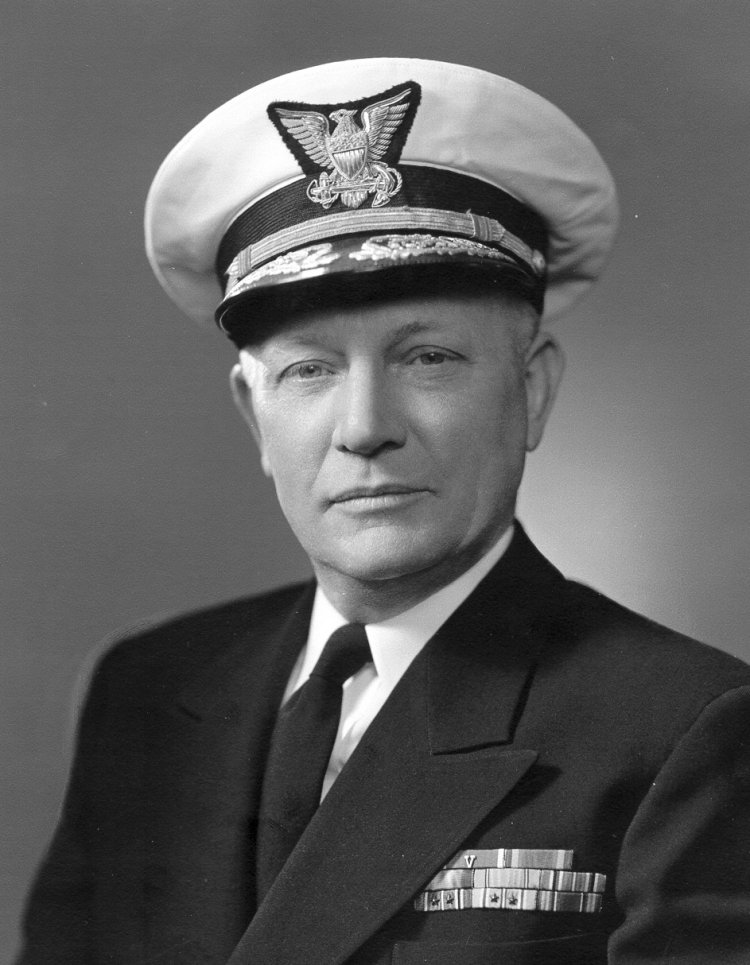

Graduating with an Ensignís commission in March 1921, he subsequently advanced as follows: LTJG, 14 November 1921; LT, 10 September 1925; LCDR, 7 March 1929; CDR, 25 May 1940; CAPT, 10 December 1942; COMM, 1 June 1945; RADM, 1 February 1946; VADM, 1 January 1950; retired 1 June 1954 with rank of Admiral. His first assignment was on board USCGC Gresham, based at New York City. During following tours of duty on board USCGC Haida (April 1922 to December 1923) and USCGC Algonquin (in 1924), he made three long Bering Sea Patrol cruises with those vessels--two with the former and one with the latter.
After returning to the Atlantic Coast on board USCGC Mojave, OíNeill was detailed to the Philadelphia Navy Yard. His assignment was connected to the conversion of the former Navy destroyer Ericsson to Coast Guard duty for the suppression of smuggling. He served first as the Executive Officer of the destroyer after she was commissioned in May 1925. He became the Commanding Officer in 1927.
In September 1927 he was assigned to the Coast Guard Academy staff as an instructor. He acquired additional duties in November 1929, when he was appointed Commandant of Cadets. He made three summer practice cruises with the cadets during that period.
Between October 1930 and June 1933 he commanded the Destroyers Monoghan, Herndon, and Cassin, respectively, on anti-smuggling operations along the North Atlantic coast. During the next two and half years, he commanded USCGC Apache.
He was next stationed at Coast Guard Headquarters, Washington, DC from October 1935 to October 1942. During that time he served in the office of Operations and was also a Technical Adviser to the United States Delegation at the International Whaling Conference in London (May-June 1937). He became the first Chief Director of the Coast Guard Auxiliary (initially known as the Coast Guard Reserve), when that organization was formed in 1939.
During World War II he commanded the Coast Guard-manned attack troop transport USS Leonard Wood in the invasions at North Africa, Sicily, Gilbert Islands, and Marshall Islands. He was awarded the Legion of Merit for exceptionally meritorious conduct in the performance of outstanding services in the Sicily campaign and the Navy Unit Commendation for the transportís "exceptionally meritorious service in action against enemy aircraft, shore batteries, mines, and submarines."
In July 1944 Admiral OíNeill became Commanding Officer of the Coast Guard Amphibious Training Unit at Camp Lejeune, New River, NC. A month later he was assigned as Commander of the Baltimore Section of the 5th Coast Guard District. His duties embraced the Captain-of-the-Port functions, the Marine Inspection Office, Pilot Stations, a Coast Guard Base, a Sub-Recruiting Station, and a Training Station at Fort McHenry.
Early in 1945 he was assigned as Assistant Chief, Finance and Supply Division, at Coast Guard Headquarters. Later that year, he was promoted to Commodore and stationed at Norfolk, VA as Commander, Fifth Coast Guard District.
By nomination of President Truman and with the confirmation of the Senate, OíNeill was appointed Assistant Commandant of the US Coast Guard with rank of Rear Admiral as of 1 February 1946. He held this post until the Commandant, Admiral Joseph F. Farley, retired on 31 December 1949. OíNeill succeeded to the post of Commandant on January 1, 1950 with the rank of Vice Admiral. (His nomination as Commandant was announced by President Truman on 12 October 1949 and was confirmed by the Senate on 14 October 1949).
When OíNeill took over as Commandant, the service had not changed much since its postwar demobilization. With a strength of just under 23,000 men, the service manned 177 cutters and 429 lighthouses in addition to various other craft and stations. Though no cutters served in combat operations, there would be considerable expansion as a result of the breakout of the Korean War in June 1950. President Trumanís executive order subsequent to the Magnuson Act saw the Coast Guard become responsible for the execution of a national port security program. In performance of these duties the Coast Guard was to ferret out left-wing subversives in the nationís merchant fleet. The subsequent heavy-handed investigations led to the serviceís greatest levels of unpopularity since Prohibition.
Due to the fact that the Coast Guard Reserve had lapsed in the years following demobilization, the Korean War spurred the appropriation of funds to build an effective Coast Guard Reserve capable of supporting the serviceís wartime missions. The emergence of the Cold War saw Coast Guard personnel man the oceangoing radio station Courier. This vessel transmitted Voice of America broadcasts from the Greek island of Rhodes.
Though short of the statutory retire age, OíNeill retired from the Coast Guard effective 1 June 1954 with the rank of full Admiral. Under his leadership the Coast Guardís peacetime strength had reached its highest levels. At the time of his retirement, military personnel numbered just over 29,000 and this was supported by a civilian work force of just under 5,000. Though it may be said that OíNeillís tenure as Commandant was relatively unspectacular in comparison to others, it should also be noted that he did provide steady, competent leadership during a period of peacetime expansion.